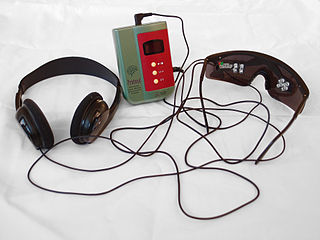- Mind machine
-
A mind machine (in some countries[which?] called a psychowalkman[citation needed]) uses pulsing rhythmic sound and/or flashing light to alter the brainwave frequency of the user.[1] Mind machines are said to induce deep states of relaxation, concentration, and in some cases altered states of consciousness[citation needed] that have been compared to those obtained from meditation and shamanic exploration.[citation needed]
The process applied by these machines is also known as brainwave synchronisation or entrainment.
Contents
Overview
Mind machines typically consist of a control unit, a pair of headphones and/or strobe light goggles. The unit controls the sessions and drives the LEDs in the goggles. Professionally, they are usually referred to as Auditory Visual Stimulation Devices (AVS devices)[citation needed].
Sessions will typically aim at directing the average brainwave frequency from a high level to a lower level by ramping down in several sequences[citation needed]. Target frequencies typically correspond to delta (1-3 hertz), theta (4–7 Hz), alpha (8–12 Hz) or beta brain waves (13–40 Hz), and can be adjusted by the user based on the desired effects[citation needed].
There have been a number of claims regarding binaural beats, among them that they may help people memorize and learn, stop smoking, tackle erectile dysfunction and improve athletic performance.
Scientific research into binaural beats is very limited. No conclusive studies have been released to support the wilder claims listed above. However, some studies[which?] indicate that binaural beats may have a little relaxing effect. Critics[who?] argue that this effect could be attributed to the power of suggestion only.
Mind machines are often used together with biofeedback or neurofeedback equipment in order to adjust the frequency on the fly[citation needed].
Modern mind machines can connect to the Internet to update the software and download new sessions. When sessions are used in conjunction with meditation, neurofeedback, etc. the effect can be amplified[citation needed].
Some clinical research has been done on the use of auditory and visual stimulation to improve cognitive abilities in learning-disabled children (research).
Safety
Rapidly flashing lights may be dangerous for people with photosensitive epilepsy or other nervous disorders. It is thought that one out of 10,000 adults will experience a seizure while viewing such a device; about twice as many children will have a similar ill effect.[2]
See also
- Hemi-Sync
- Brainwave synchronization
- Binaural beats
- Dreamachine
- Electroencephalography
- Neurofeedback
- Human enhancement
- Intelligence amplification
- Neural oscillations
- Evoked potential
- Event-related potential
- Induced activity
- Ongoing brain activity
- Psychedelic drug
References
- ^ The Use of Auditory and Visual Stimulation for the Treatment of Attention Deficit Hyperactivity Disorder in Children. Micheletti, Larry S. Doctoral Dissertation, University of Houston, Houston, Texas
- ^ Allen, Mark (2005-01-20). "Décor by Timothy Leary". The New York Times. http://www.nytimes.com/2005/01/20/garden/20mach.html?ex=1264050000&en=2ead60550b324624&ei=5088&partner=rssnyt. Retrieved 2007-03-27.
Categories:- Meditation
- Self
- Devices to alter consciousness
Wikimedia Foundation. 2010.

